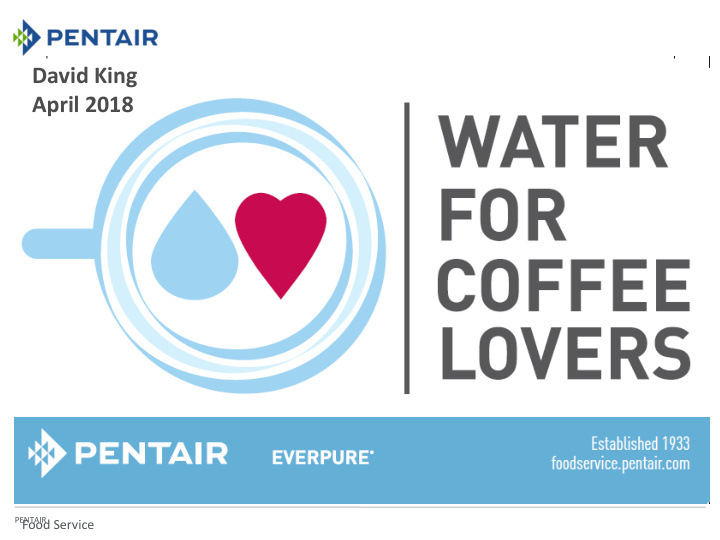



David King April 2018 David King November 2017 PENTAIR Food Service
PENTAIR Food Service 2
Water for Coffee Lovers 1. Water chemistry fundamentals 2. The importance of minerals 3. Equipment protection 4. Water treatment technologies Food Service
Water Chemistry – Fundamentals 1. Total dissolved solids (TDS) (ppm) 2. Total hardness (ppm) 3. Carbonate Hardness or Alkalinity (ppm) 4. pH Food Service
The Hydrological Cycle 5 PENTAIR Food Service
Asia - Variable Water Conditions ( TDS) South Korea 1. Australia - Melbourne 30 – 50 ppm 2. Australia - Perth 380 – 600 ppm Taiwan 3. S. Korea - Seoul 100 - 480 ppm Hong Kong 4. Philippines - 70 – 400 ppm 5. Vietnam - 70 – 200 ppm 6. Indonesia – 100 -250 ppm Singapore Australia New Zealand 6 PENTAIR Food Service
How much chlorine do you serve with your coffee ? Food Service
Filter demonstration Food Service
How does the chemistry of water affect coffee ? Food Service
Mineral Content of Water Total Hardness Alkalinity TDS (ppm) pH (ppm) (ppm) WBC Water Spec 120 -150 60-85 40 7 - 8 Australia ( Melb) 30 30 10 7.7 Australia ( Perth ) 600 300 190 7.6 S. Korea ( Seoul ) 150 60 30 7.6 S. Korea ( Seoul ) 480 230 200 7.7 Vietnam 200 80 60 7.6 Indonesia 250 110 90 7.5 , PENTAIR Food Service 10
Protecting the coffee machine Langelier Saturation Index (LSI) Scale Corrosion Food Service
Water Quality – Testing 1. Litmus paper 2. Titration 3. Digital meters (spectrometer, photometer ) Food Service
Water Treatment Technologies 1. Removal • Carbon block • Sub micron filters • Reverse Osmosis 2. Exchange • Softening • Partial Softening 3. Addition • Minerals • Scale Inhibitors Food Service
Everpure Conserv Reverse Osmosis System Features and benefits: 1. Control of mineral content. 2. Balances water chemistry. 3. High efficiency membrane. GBU OR VERTICAL
Summary 1. Chemistry fundamentals - understand what can be in your water. 2. A solvent free from impurities taste and odour – Taste the water after the filter, is it good enough to drink 3. Water testing – Test your water or have your water tested for the appropriate dissolved minerals. 4. Solutions – Select the appropriate solution based on the water testing Food Service
Recommend
More recommend